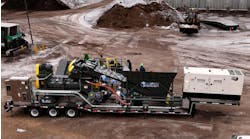Download this article in PDF format.
Too often, design engineers look at coating parts as an afterthought. Rather than being part of the discussion in the early stages of design, engineers sometimes try to solve problems with coatings during—or even after—manufacturing. While surface treatments such as anodizing, electroplating, and thermal spray provide their own unique set of properties and benefits, these processes also have limitations that demand attention early in the design process to ensure optimal performance.
Engineers often look to extend the life of equipment by protecting parts from wear and abrasion. Protective coatings not only guard these parts against these issues, but also provide lubrication and increase structural integrity. Using the right surface treatment can increase a part’s lifespan, cut downtime, and reduce overhead.
Key factors affecting surface treatment at the outset of the design process are:
- Process limitations
- Choice of base metal
- Part configuration and design
- Surface finish
Engineers risk lengthening product cycle times by not making surface-treatment discussions a primary consideration early in the design process. When going this route, they risk specifying a treatment that cannot be completed due to the design properties of the part in question.
Process Limitations
Some parts (like that shown) are subject to line-of-sight process restrictions, or they require special equipment to process them.
Most common with electroplating, anodizing, spray coatings and physical-vapor-deposition (PVD) methods, “line-of-sight” is one of the most frequent process limitations encountered by engineers. In general, the rule with these processes is “what you see is what you can coat.” Engineers need to consider a more suitable immersion process for parts with hidden surfaces that require treatment.
With line-of-sight applications, the engineer is usually limited to between one and one-and-a-half times the diameter for the coating’s depth to uniformly penetrate down the hole. That’s due to the limited throw of a line-of-sight process. Thus, parts with deeper holes will not have a uniform coating thickness. This could become a significant issue for parts with tight tolerances, unless special anodes are developed for these deep-hole applications.
Parts with deep blind holes are subject to air pocketing and may require special fixtures or position to ensure continuous coating.
Air pockets, or pocketing, which is air trapped in the cavity of a part, is an issue often found with immersion processes such as anodizing and plating. If a critical surface needs a coating, the engineer must ensure access to that surface so the coating vendor can remove the pockets. Pocketing reduces the coating efficiency, too, because the part often has to be oriented at different angles and then maneuvered to remove the air. Intricately designed parts are more susceptible to this issue, so engineers also need to consider designing in relief holes to allow the air to escape.
Base Metal Choices
Communicating early with your coating vendor on the choice of base metal for the part can also eliminate issues later in the design process, especially if the part has tight tolerances. That’s because subsequent processing temperatures may have a damaging effect. Deformation can occur if application surface loads are high and coating process or post-process temperatures exceed the substrate’s heat-treatment recommended operating temperatures. Besides deformation, some metals suffer from structural stability issues where the part moves or changes size.
When considering high-strength alloys or materials such as titanium or tool steels, part designers should be aware of hydrogen embrittlement, which can cause the part to crack and fail under loads. During the cleaning process, which often involves acidic materials, certain alloys will impart hydrogen to the surface of the metal, leading to the embrittlement. If the coating vendor is aware of this, they can perform specialized procedures to the part after coating, or use alternative cleaning processes to expel the hydrogen from the surface and avoid the issue.
Engineers sometimes design a part that incorporates more than one material. In this case, the part may not be conducive to plating surface treatments because the cleaning methods before coating are different for each type of metal. One cleaning process may activate the surface of a given metal for coating while passivating the surface of the second material. If you can’t coat both surfaces at the same time, you’ll need special masking, which drives the cost up due to its labor–intensive nature.
Adhesion issues on the boundary areas between the two metals also occur. When you expose them to electrolytes, there may be a galvanic reaction between the two materials, creating corrosion of one of the base materials.
In addition, if the base metal of the part is hard, it can cause surface tensions that prevent a strong adhesion between the base material and coating. A bad bond between the part and coating will lead to chipping of the coating.
Part Configuration
For many plating types, a sharp corner is the designer’s greatest enemy, since sharp corners are subject to chipping. Thus, it is always advisable to radius the parts, depending on the required coating thickness. A greater radius provides more support for the coating and minimizes chipping, but if a sharp corner is absolutely necessary, then the coating thickness should be kept to a minimum.
Some processes that require electrical current to generate the coating produce an unwanted effect on sharp edges and corners of parts, which translates to greater coating thickness in those areas and less in other areas. If the part has tight tolerances, you’ll need subsequent machining operations that increase both costs and time. Designing parts with enough corner and edge breaks helps avoids this issue.
If a part has thin areas of metal, then these spots can be prone to burning. When high voltages are necessary during coating, thin sections of metal generate high amperages, which can cause those areas to burn. Your metal-finishing expert will have to adjust their coating techniques to minimize this potential.
Size also matters when coatings are a consideration. Tank size limits immersion-coating processes, so designers need to communicate with the vendor to see what size parts they can accommodate. In the case of heavy parts, you need to discuss material-handling capabilities.
Coating Considerations
This table reveals the radius of curve required to achieve a nominal coating thickness.
Because parts must be racked before they are coated, it is important to discuss racking early in the design process with your coating vendor. Racking may lead to the part being left uncoated at areas where they come in contact with the rack, or the part may end up marked by the racking process. If the part is large, then it cannot be suspended by a small hole, so significant rack points need to be considered. In certain processes, particularly anodizing and electroplating, the racks act as a current-carrying device. Therefore, correct positioning of the racks is critical, as is the number of rack points required to achieve a uniform coating.
Some applications require areas of the part to be free from coating. This leads back to the labor-intensive issue of masking—engineers should not underestimate how much this process adds to the overall cost. If cost is an issue, then it is best to design a part that can be coated all over.
Tight Part Tolerances
This table illustrates the change in pitch diameter per unit of coating thickness.
Each coating process has specific thicknesses and tolerances to which the coating can be applied. Depending on the process selected, parts may or may not require machining after applying the coating. Engineers should pre-size parts to accommodate coating thickness and tolerances wherever possible.
Coating thickness should be a primary consideration for engineers, especially where tight tolerances are required. Certain processes like plating are described in terms of surface growth. For example, 0.001 in. of a coating will be equal to 0.001 in. of surface growth. Other methods, such as anodic processes, are described in terms of a combination of penetration and surface growth. In this case, 0.001 in. of a coating may only be equal to 0.0005 in. of surface growth because the coating penetrates the metal’s surface.
Threads often have tight tolerances, especially on the pitch diameter where the two parts engage each other. On a 60-degree thread form, every unit of coating thickness applied to the surface will affect the pitch diameter by four times that amount. If threads need a coating, they should be pre-sized to accommodate the coating-thickness requirement to ensure proper engagement.
Surface Finish
Some coating processes will replicate the surface finish, but only down to a certain degree—measured in units of Ra. For instance, plating a surface can replicate as low as 16 to 32 Ra finish. For lower Ra values (i.e., better finish), post grinding or polishing is necessary.
With so many considerations, it is critical for the engineer to make sure they communicate with the coating vendor to ensure an efficient design and manufacturing process. Not only can this produce a faster product cycle time, it can also reduce costs and ensure better part performance in the field.















